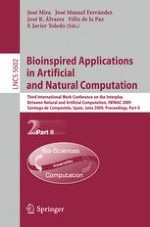2009 | OriginalPaper | Buchkapitel
Neurobiological Significance of Automatic Segmentation: Application to the Early Diagnosis of Alzheimer’s Disease
verfasst von : Ricardo Insausti, Mariano Rincón, César González-Moreno, Emilio Artacho-Pérula, Amparo Díez-Peña, Tomás García-Saiz
Erschienen in: Bioinspired Applications in Artificial and Natural Computation
Verlag: Springer Berlin Heidelberg
Aktivieren Sie unsere intelligente Suche, um passende Fachinhalte oder Patente zu finden.
Wählen Sie Textabschnitte aus um mit Künstlicher Intelligenz passenden Patente zu finden. powered by
Markieren Sie Textabschnitte, um KI-gestützt weitere passende Inhalte zu finden. powered by
Alzheimer’s disease is a progressive neurodegenerative disease that affects particularly memory function. Specifically, the neural system responsible for encoding and retrieval of the memory for facts and events (declarative memory) is dependent on anatomical structures located in the medial part of the temporal lobe (MTL). Clinical lesions as well as experimental evidence point that the hippocampal formation (hippocampus plus entorhinal cortex) and the adjacent cortex, both main components of the MTL, are the regions critical for normal declarative memory function. Neuroimage studies as ours, have taken advantage of the feasibility of manual segmentation of the gray matter volume, which correlates with memory impairment and clinical deterioration of Alzheimer’s disease patients. We wanted to explore the advantages of automatic segmentation tools, and present results based on one 3T MRI in a young subject. The automatic segmentation allowed a better discrimination between extracerebral structures and the surface of the brain, as well as an improvement both in terms of speed and reliability in the demarcation of different MTL structures, all of which play a key role in declarative memory processing. Based largely on our own nonhuman primate data on brain and hippocampal connections, we defined automatically the angular bundle in the MTL as the fibers containing the perforant path (interconnection and dialogue between the entorhinal cortex and its hippocampal termination. The speed and accuracy of the technique needs further development, but it seems to be promising enough for early detection of memory deficits associated to Alzheimer’s disease.
